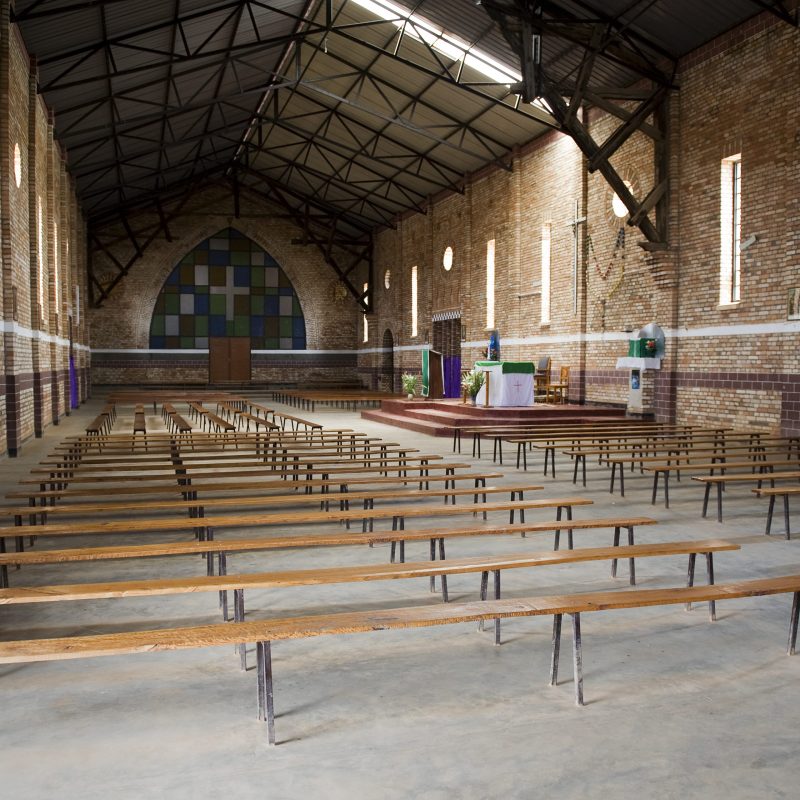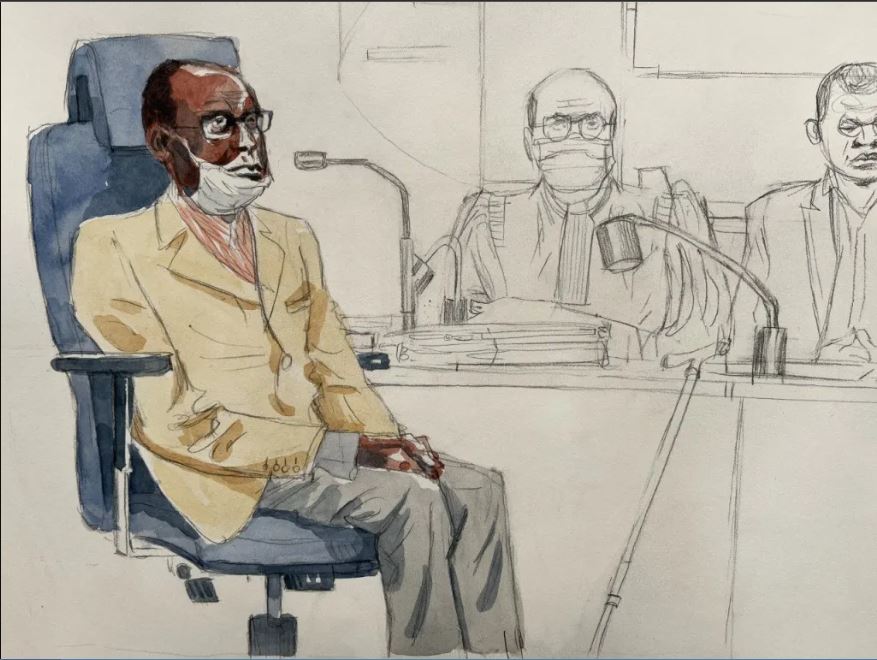
Kibeho Parish was turned into Memorial in the back end. In several churches Padiris(priests) participated in the Genocide against Tutsi which compelled some Christians to believe that they are not upright as they thought
As I follow the case of Bucyibaruta, now taking place in Paris criminal court, my mind constantly travels back to Murambi, Cyanika, Kibeho and especially Kaduha where the crimes of genocide of which Bucyibaruta is accused, were committed, during the 1994 genocide against Tutsi.
With every mention of this or that event, at this or that time, made in the courtroom in Paris, my then 14 year old self, keeps tapping me on the shoulder, taking me back to Rwanda in 1994, to say, oh, yes, remember that?
The planning for murders that would culminate in 1994, was already in plan in 1990 and way earlier. 1994 would simply be an intensification of formats and strategies that had been played out in 1959, in the 1960s, and throughout the 90s, with ’94 designated as the “final solution” of the “Tutsi problem”. This is the Rwanda in which I grew up.
From the outset, I was of course, made aware by the system, from my teachers, the authorities both local and national, that I was a Hutu, and that that was a good thing to be, unlike my friends, who were Tutsi, which for reasons that were never quite clear to me, was such a bad thing, it verged on evil.
It was a tightly controlled Rwanda. The presence of state authority always loomed large in our lives.
As Prefet, Bucyibaruta, was master of all he surveyed in Gikongoro. Although I glimpsed him, I think only once, his was a name familiar to everyone. Towards the end of my Primary school education, at Ecole Primaire de Musange, we learnt about him in civic education classes, when we learnt about the country’s leaders, and of course, the three ethnic groups, and the supposed nature of each one of them.
When they talked about him, which was often, the adults talked about Bucyibaruta in respectful, reverential terms. In those days, such leaders were second only to the national leaders, who dwelt in the Olympian heights of Kigali.
My home was only a few minutes’ drive (or a 40 minute walk, since in our village any form of motorized of transport, was a rarity) from Bucyibaruta’s village house at Nyaruzi, on the opposite hill of Musange commune headquarters.
Commune was then a local administrative entity which is more like a sector nowadays.
To say, “Kwa Bucyibaruta” (at Bucyibaruta’s), was to speak of an enchanted place, so far removed from the rest of us, that as ardently desired as it was, we did presume to wish for it.
As witness, after witness on either side, recounts their recollections in the Paris court, I am taken back, seeing the places, and events they describe, through my 14 years old eyes.
There is little of what is being said in that Paris courtroom, that I did not witness, first hand, see with my own eyes, although I did not then fully grasp the politics behind it.
I can once again, see the terror, the unfathomable suffering, that my Tutsi neighbours and friends went through. Now, with children of my own, in a Rwanda, so different from the country in which I grew up, it may as well be a different planet, I am still bewildered by the why of it all.
In Rwanda, most settlements are generally built on hills. Home for me, was on Murambi hill(not the Murambi of Nyamagabe), which offered a panoramic view of surrounding neighbourhoods in Musange Commune.
Prompted by one or other witness in the Paris courtroom, I see, as though it were only yesterday, Tutsi neighbours from the surrounding hills of Kigoma, Kinzira, and Cyabagomba. I can see my neighbours, men, women, young, old, children of all ages, fleeing, carrying only the few belongings they could carry, and had hurriedly put together.
For the oldest among them, the terror was being relieved. They might have recognized the signs. First, the increased intimidation from their Hutu neighbours. Incidents such that of Mpakaniye and his Tutsi neighbour, Sebuturo, both of whom I knew well.
Sebuturo was regarded with both affection, and respect, in the village, a man of integrity. Mpakaniye, who was younger than his neighbour, would be the first to help the older man till his farm. As the hate intensified however, we would hear Sebuturo, calling for help. Mpakaniye had taken to harassing, and attacking his former friend and neighbour. Sebuturo, would be one of the many, far too many people I knew, who would be murdered in the genocide.
The older people also thought, from experience, that official venues, like the commune, would be safe, as officials did not want to be seen leading, or allowing murder. But things had changed, since they were last hunted down. The planners of the “final solution” had ordained that there would be no refuge, anywhere.
Not even in the “house of God” would sanctuary be found. Tutsi from Mugote, Mugano, Joma and other hills, who fled to Kaduha Catholic parish, hoping to find refuge, would be massacred, in the church, where I was baptized. Among the killers, was allegedly Father Nyandwi, a senior priest, well known to all of us.
In Paris, witnesses for the defence, including 70 year old Hategekimana, who was then sous prefet of Kaduha, under Bucyibaruta, say that these massacres were committed by the gendarmes (military police) whom they claim Bucyibaruta had sent to protect the Tutsi. “They disappointed us” claims Hategekimana now.
We know however, that rather than protecting the Tutsi, the military, including the gendarmes, were always sent in to organize, support, or to reinforce the Interahamwe militias.
In Kaduha, on advice of the gendarmes, witnesses said that local officials and interahamwe encamped at Gitega which is nearly 30 minutes’ walk from the parish.
At the fateful moment, a grenade was thrown in the midst of the huddled crowd, the Interahamwe followed, shouting, blowing whistles, and fell on the Tutsi in a killing frenzy.

Laurent Bucyibaruta before Paris Court
Even though I was not in Kaduha, the presence of the gendarmes and their part, seemed obvious, even to my teenage self. None of us can forget hearing the sounds of gunfire, fire from early morning. By 3pm in the afternoon, we could see lines of Tutsi, who had managed to survive, staggering away, fleeing for their lives.
I was spared the sight of the main site of the murders, as the view of Kaduha, from my village of Musange, is shielded by Mugote hill. But I would not escape the image that remains an indelible memory, of those fleeing being hacked to death, by the chasing Interahamwe.
A hand grenade thrown into the fleeing, terrified group by river Muhura, sticks in the mind. Word went around that it had been thrown by one Kayiranga, whom we knew as police officer, at the commune.
The few Tutsis who fled to the Commune Musange, were gunned down, and wiped out, a day or two later, as I recall.
One of the ironies, missed in the court in Paris, perhaps, because they are so far from Rwanda, is that defence witnesses seeking to exonerate the accused, say he was such a good man, they called him “Padiri” or father.
There were of course, individual priests who lived up to their calling, but the word Padiri was now to be associated with Nyandwi, who, allegedly joined the Interahamwe to proudly be covered in the blood of the innocents they were murdering.
The Churches, in general, the Catholic Church in particular, was part of the genocidal establishment, and we know that many priests and nuns, vied with the Interahamwe, as to who could murder the most Tutsis. The word Padiri as someone who offered pastoral care, had become a mockery, and some would suggest it has never recovered.
The prosecution asserts that far from sending them “protecting Tutsi” as the defence claims, the accused sent them to organize the Interahamwe to carry out what was euphemistically called “work.”
It is according to the prosecution, a pattern that would be repeated in Murambi, Cyanika, Kibeho and other places, where the murders were at their worst.
Involvement in Genocide atrocities by some priests in cases of Father Athanase Seromba of Nyange, Emmanuel Rukundo of Kabgayi and Wenceslas Munyeshyaka of Sainte Famille would call for a different story.

